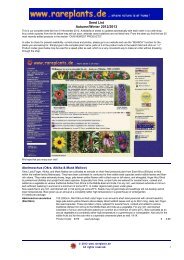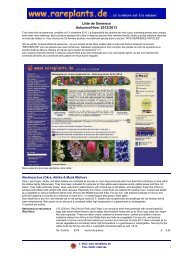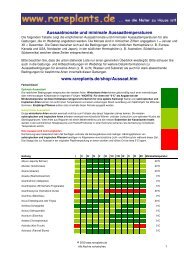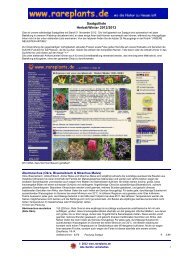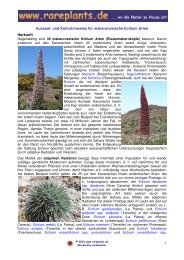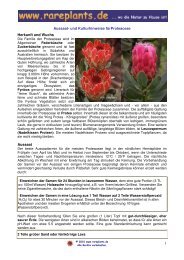Lista de Semillas Otoño/Invierno 2012/2013 - Bjorn Malkmus Rare ...
Lista de Semillas Otoño/Invierno 2012/2013 - Bjorn Malkmus Rare ...
Lista de Semillas Otoño/Invierno 2012/2013 - Bjorn Malkmus Rare ...
Create successful ePaper yourself
Turn your PDF publications into a flip-book with our unique Google optimized e-Paper software.
Anacardia occi<strong>de</strong>ntalis<br />
(Cashew Nut)<br />
Anagyris (Gold of the Rocks)<br />
3 (15)m, Cashew Nut is a tall shrub to medium-sized tree with small fragrant, whitish to pink flowers. The<br />
edible and very aromatic yellow to red "fruit" (Cashew Apple) is actually the swollen, juicy flower stalk<br />
which actually looks like a pear. The kidney-shaped Cashew fruit is hanging at its bottom. The seed is<br />
located insi<strong>de</strong> this rather large nut. It is roasted and salted and sold at rather high prices. Fresh and whole<br />
seeds are very hard to obtain! Seeds from a plantation near Salvador da Bahia in northern Brazil,<br />
harvested and imported end of August - absolute freshness and viability is guaranteed! For any rich, well<br />
drained substrate in full sun throughout the yeat with reduced watering and a minimum of some 15°C in<br />
winter.<br />
Seeds are not available for a <strong>de</strong>livery to Australia and the the U.S.<br />
No. <strong>de</strong> artículo: 2106 sobre <strong>de</strong> semillas<br />
€ 7,99<br />
Anagyris or "Oro <strong>de</strong> Risco" (Gold of the Rocks) as it is locally called, is a beautiful, yet threatened woody, semi-evergreen shrub with<br />
ornamental terminally born clusters of large, bright gol<strong>de</strong>n yellow flowers and fresh green trifoliate leaves. They are easily cultivated as pot<br />
plants in any humus rich, well drained soil in a sunny spot. Keep frostfree in winter at a minimum of some 5°C in full sun with watering<br />
reduced to a minimum.<br />
Sow the large, violet-black seeds flat in any rich, well drained, slightly sandy to rocky soil at some 20°C throughout the year. Keep<br />
seedlings very sunny, especially in their first winter.<br />
7 semillas gran<strong>de</strong>s por sobre.<br />
Aviso legal: De acuerdo con las leyes alemanas nacionales (BNatSchG y BArtSchV) tan bien como las convenciones a nivel europeo<br />
(Convención <strong>de</strong> Berna) e internacional (Convention on International Tra<strong>de</strong> in Endangered Species of Wild Fauna and Flora - CITES) no<br />
ven<strong>de</strong>mos ningún material tal como semillas proveniendo <strong>de</strong> plantas salvajes protegidas. Las semillas <strong>de</strong> dichas plantas protegidas<br />
<strong>de</strong>rivan exclusivamente <strong>de</strong> plantas propagadas artificialmente en cultivos hortículos en Alemania respectivamente en el Líbano, don<strong>de</strong> las<br />
plantas se han tomado en cultivo a finales <strong>de</strong> los años 70 y al principio <strong>de</strong> los años 80 <strong>de</strong>l siglo pasado.<br />
Anagyris foetida<br />
(Mediterranean Gold of the<br />
Rocks)<br />
200 (400)cm, Mediterranean Gold of the Rocks is an ornamental woody, semi-evergreen shrub with large,<br />
bright gol<strong>de</strong>n yellow flowers in terminal clusters and fresh green, trifoliate leaves. A rarely cultivated<br />
species from rocky open spots in the Mediterranean. Keep always sunny and in winter frostfree at a<br />
minimum of some 5°C. III-V.<br />
No. <strong>de</strong> artículo: 7121 sobre <strong>de</strong> semillas<br />
€ 4,99<br />
Anchomanes (African Titan Aroid) & Pseudohydrosme<br />
African Titan Aroids and the closely related genus Pseudohydrosme are native of Africa and contain some 7 to 8 species in Anchomanes,<br />
respectively only one species (Pseudohydrosme gabunensis) in the monotypic genus Pseudohydrosme. They differ from Amorphophallus<br />
in having always spiny stalks and <strong>de</strong>eply dissected leaves, and tuberous, spreading rhizomes with perennial roots. All can be successfully<br />
grown in any rich, well drained, slightly moist soil in a partially sha<strong>de</strong>d to sunny spot. Keep plants always warm at a minimum of some<br />
20°C throughout the year, <strong>de</strong>crease watering as soon as plants go dormant. The inflorescence appears with or shortly before the new leaf<br />
is formed.<br />
Plants are easily raised from seeds, sow the usually quite large seeds horizontally in any rich, well drained soil. Keep soil always slightly<br />
moist. Keep at 20° - 30°C throughout the year in a sunny to partially sha<strong>de</strong>d spot. Seedlings will usually grow continuously for about two<br />
years before going dormant for the first time.<br />
2 semillas gran<strong>de</strong>s por sobre.<br />
Note: All corms are available for a <strong>de</strong>livery within Europe only ! Seeds are shipped worldwi<strong>de</strong>. For Non-European customers only: We do<br />
ship dormant tubers outsi<strong>de</strong> Europe, provi<strong>de</strong>d that all risk is upon the buyer. We do not issue any phytosanitary certificate, which is<br />
officially required for most countries. We kindly ask you to check with your local import regulations before placing an or<strong>de</strong>r!<br />
Anchomanes dalzielii 150 (200)cm, is a rarely cultivated species which is similar to Anchomanes difformis, and it differs in<br />
having broa<strong>de</strong>r leaflets and red fruits. It has a very tall, prickly, brownish green mottled stalk and a large<br />
leaf umbrella of <strong>de</strong>eply dissected, glossy leaflets. The pale green spathe and creamy-white spadix are<br />
born on a 150 tall stalk, the inflorescence is followed by a very ornamental, upright to horizontally held<br />
infructescence of green berries turning red on maturity. A very easy and showy species for any rich, well<br />
drained soil. III-VII.<br />
Anchusa (Bugloss)<br />
Fotos from this species are available from the International Aroid Society website:<br />
http://www.aroid.org/genera/speciespage.php?genus=anchomanes&species=dalzielii Anchomanes<br />
dalzielii.<br />
No. <strong>de</strong> artículo: 8415 sobre <strong>de</strong> semillas<br />
€ 19,90<br />
Sow seeds flat directly to the ground in any rich, well drained soil in spring. Plants greatly dislike to be transplanted, thus leave<br />
undisturbed. All annual species will readily selfsow un<strong>de</strong>r appropiate conditions. In a mild winter seedlings will survive outsi<strong>de</strong> if they are<br />
not burnt by strong freezings. Alternatively collect some seeds in summer to be sowed in following spring.<br />
Todas las plantas son <strong>de</strong> la Zona Climática USDA 7/8.<br />
10 semillas por sobre.<br />
Anchusa azurea<br />
(Italian Bugloss)<br />
Anchusa officinalis<br />
(Common Bugloss)<br />
No. <strong>de</strong> artículo: 6902 sobre <strong>de</strong> semillas<br />
€ 4,79<br />
30 (50)cm, Common Bugloss is a showy biannual to short-lived perennial with branching stems and<br />
terminal, intense sky-blue flowers above bristly leaves. Native of rocky soils in sunny spots throught<br />
central and northern Europe extending eastwards to western Asia. For any rich, well drained soil in full<br />
sun. Excellent in a protected spot in the rock gar<strong>de</strong>n. V-VI.<br />
No. <strong>de</strong> artículo: 6352 sobre <strong>de</strong> semillas (ex Frescati, Estocolmo, Suecia)<br />
€ 2,99<br />
© <strong>2012</strong> www.rareplants.<strong>de</strong><br />
Todos los <strong>de</strong>rechos reservados.<br />
36




